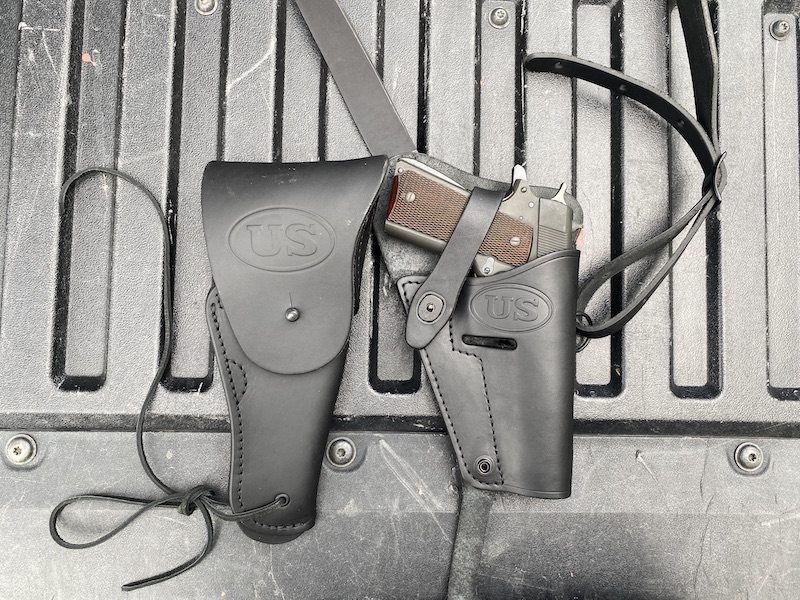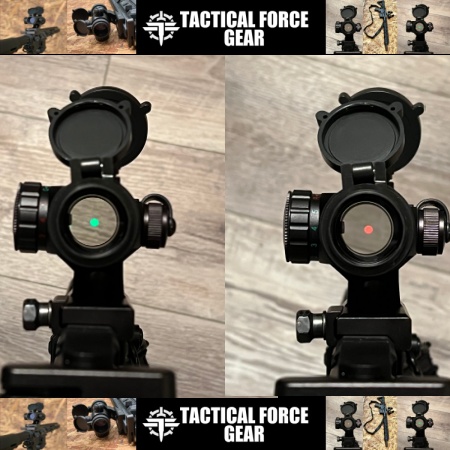Of all the semi-autos on the market, the 1911 is still the single easiest gun to holster, so 1911 fans have lots of leather holsters to choose from. There are amazing options for just about every style of carry. Now, 1791 Gunleather is adding a retro homage to that lineup with the GI Hip Holster and the M3 Tanker.
Both of these are close approximations of the originals. For anyone needing a working holster (as opposed to an original collector’s item), both of these options should be on your shortlist. While there are very small points in both builds that differ from the originals, these would likely pass muster—even for reenactors (just make sure you end up with the right color for the era you want to recreate). We wouldn’t want anyone to think we were promoting anachronisms.
The M3 Tanker is an homage to the not-quite-shoulder holsters American GIs wore in WWII. The GI Hip Holster is a throwback to the old GI flap holsters that were in service for the better part of the 20th Century. Both come in black or brown and are made by 1791 Gunleather.
Get side-tracked with the history of the M3 Tanker.
If you’re ever curious about military history, the internet is the greatest library available. Its search options suck, if I may be so blunt, but the information is there, typically buried deep in discussion threads. This is where the genuine experts live and die, and searching for the development of the M3 Tanker and the later M7 variant will yield hours of reading material.
The M3 was the original tanker holster of WWII. It held the gun up on the left side of your ribs, almost under your arm. This orientation was good for those in vehicles or those who did a lot of sitting, as it kept the gun from hanging obtrusively from the belt in tight spaces.
M3 Tankers have a long shoulder strap and a shorter belt strap. They were originally made by three companies: Boyt, Enger-Kress, and Sears Saddlery. All of them were brown.
Practice Makes Perfect
By the end of the war, the M7 had solved some of the problems of the M3 hanging too far under the arm. The M7 has an additional strap that allows it to be positioned further toward the middle of the torso, making it easier to access if it is worn under a jacket.
Postwar production of the M7 continued, and in 1956, the Army switched its dominant color scheme of boots and holsters—the uniform leather goods—from brown to black.
This isn’t completely useful information for most of us, and I didn’t know it before I began trolling forums during a recent bought of insomnia, but I’m hoping I’ll be able to whip it out in a pub trivia quiz one day and wow the ladies.
The GI Hip Holster’s Evolution
The USGI Model 1916 holsters were in production for a long time. They were far more common and made by at least 17 different makers. These flap holsters were a simple design that originated well before 1916—back in the 19th century at least, if not earlier. In their institutional usage, these designs evolved with the guns to fit those old Colt percussion guns, then single-action revolvers, then 1911s, then a series of double-action revolvers. They stayed in service until canvas versions replaced them.
The design has also evolved. Belt loop sizes change, the metal clip addition allows the holster to be worn on a web belt, and the color changes back and forth from black to brown (depending on how far back you want to trace the family tree).
A note on the evolution of holster: Flaps aren’t fast. What we think of now as the typical Hollywood-style gun rig began with a flap holster with its flap cut off. The flap, though, is a viable means of retention. For the military, which uses the sidearm as a secondary weapon, the flap is insurance that it stays in place.
However, you can see the change occurring with the M3 and its strap, which requires much less leather and holds the gun just as tightly.
A Note On The GI Hip Holster’s Break-In Period
When I first got this holster in for review, I couldn’t fit a 1911 in this holster much past halfway. Leather, though, is malleable and will stretch.
I don’t believe a break-in should be required, but that’s me. As such, I contacted 1791 and was advised to wrap the 1911 in a Ziplock bag and force it in. I assume this was meant to protect the finish from abrasion—after all, you may want to holster a really nicely blued-Colt or something else on the fancy side.
Wrapping a gun like this isn’t uncommon for holster makers. Wet-molded leather works best with the real gun in the holster, but you don’t really want to get guns wet, so the plastic helps. But 1791 wasn’t advising wet-molding, just stretching.
So unload, cock-and-lock (so it doesn’t slide out of battery), and jam it in was what I was told to do.
I pushed in, left it for a few hours, and then pushed some more. In the end, I had to fully jam the gun home by leaning on the grip with the holster firmly nose-down on a solid table. Only then could I get it to button shut.
Not So Easy
I want to be 100% transparent here: This was a pain in the rear. 1791’s holster is also a solid homage to the originals and worth the effort, but I’ve been working with this one off and on for a couple of weeks now, and it is to the point that I can get it in with a healthy amount of push, but it is still very tight.
While I characterize this as a pain, I want to focus on the positive. It isn’t like this is a cheap knockoff made of dried-up horsehide. This is a robust build and one that should age very gracefully. The time you might spend getting the fit right will pay off. The only thing to watch out for is your front sight. Don’t damage it by forcing the gun in, and watch for the backside of a steel sight (like the right angle on the Springfield Milspec below) cutting a channel inside when you draw.
Should you carry cocked and locked?
Maybe. The thumb safety is on the inside of the holster. There should be no way to disengage it by bumping the gun. This, though, should be one of those things you pay close attention to.
The grip safety may be depressed by the strap, which adds more responsibility to that thumb safety.
The trigger, though, is well protected. I would carry cocked and locked with no hesitation, but I’d make it a point to check the safety status from time to time.
On the flap holster, the grip safety won’t be depressed. It could be while you are holstering the gun, but you always have the thumb safety up when you’re not ready to shoot, right? Of course you do.
1791’s New Direction
Both of these have MSRPs under $100. This is a solid build for that, and one that has high material costs (both designs use a lot of leather). And I like the new direction for 1791. Finding good representations of military holsters isn’t easy. For guns like the Mil-Spec, which is a close homage to the old 1911A1, this is a perfect pairing.
In short, these are ideal for collectors who aren’t looking for originals they have to baby. They are meant to be carried and worn, and 1791 built them to take the abuse of actual use.
Read the full article here










